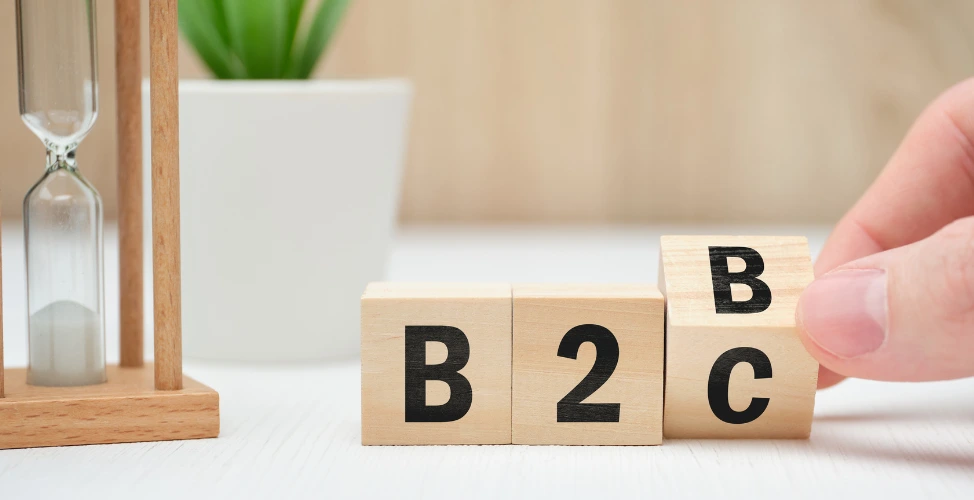What is B2B and B2C? Differences between B2B and B2C
In today’s dynamic business landscape, understanding your target audience is paramount for success. This is particularly true when it comes to crafting effective marketing and sales strategies. Two distinct categories emerge: B2B (business-to-business) and B2C (business-to-consumer). While both involve selling products or services, the approach and considerations differ significantly.
This guide delves into the world of What is B2B and B2C, exploring the core differences between these two models and how they impact your approach to customer acquisition and retention. By understanding these distinctions, you can develop targeted strategies that resonate with your specific audience and propel your business forward.

What does B2B mean?
B2B stands for business-to-business. This refers to a business model where the products or services are sold directly from one company to another. In simpler terms, it’s businesses selling to other businesses. Here are some key characteristics of B2B transactions:
- Target Audience: Other businesses, organizations, or institutions.
- Decision-making Process: Purchases typically involve multiple decision-makers within the buying company, with a focus on factors like functionality, cost-effectiveness, and return on investment (ROI). Extensive research and evaluation often precede a purchase.
- Relationships: B2B relationships are often built on long-term partnerships and strong supplier-customer connections. Trust and reliability are paramount.
- Products/Services: B2B products and services can be a wide range of offerings, from raw materials and industrial equipment to marketing software and financial services such as fintech, blockchain. These products and services are typically used to support the operations or improve the efficiency of the buying company.
What does B2C mean?
What is B2B and B2C? B2C stands for business-to-consumer. This refers to a business model where the products or services are sold directly to individual consumers for personal use. In simpler terms, it’s businesses selling to individual people. Here are some key characteristics of B2C transactions:
- Target Audience: Individual consumers, focusing on a broad range of demographics and needs.
- Decision-making Process: Purchases are often made by a single individual, with a greater emphasis on emotional factors like brand image, product features, and value perception. Decisions can be more impulsive compared to B2B buying journeys.
- Relationships: B2C relationships tend to be more transactional, with a focus on individual purchases rather than long-term partnerships.
- Products/Services: B2C products and services encompass a vast array of consumer goods, from clothing and electronics to food and entertainment services. These products and services are intended for personal use or consumption by individual buyers.
See more: 6 Best eCommerce CMS for Online Businesses
Similarities of B2B and B2C
What is B2B and B2C? While B2B and B2C models cater to distinct audiences and involve different approaches, they share some core underlying principles:
- Human Connection: At the heart of both B2B and B2C interactions are real people making decisions. Whether it’s a purchasing manager for a company or an individual consumer, understanding their needs, motivations, and buying behaviors is crucial for success.
- Customer Experience Matters: In today’s competitive landscape, exceptional customer service and a positive customer experience are essential for both B2B and B2C businesses. This encompasses everything from pre-sale interactions and product information to post-purchase support and building customer loyalty.
- Customer-Centric Sales Approach: Effective sales strategies in both B2B and B2C models prioritize the customer’s needs. Moving beyond simply pushing products, successful businesses focus on understanding customer challenges and demonstrating how their offerings provide valuable solutions.
- Problem Solvers at Heart: At their core, both B2B and B2C businesses exist to solve problems for their target audience. Whether it’s increasing efficiency for another company (B2B) or offering a convenient solution for a daily task (B2C), understanding the problems your audience faces is essential for crafting compelling value propositions.
- Building Trust and Credibility: Regardless of whether you’re targeting businesses or individual consumers, establishing trust and credibility is paramount. This can be achieved through factors like a strong brand reputation, positive customer reviews, and transparent communication. By demonstrating authenticity and building trust, you can foster stronger relationships and encourage engagement with your brand.
Differences between B2B and B2C
Target Audience
- B2B: Focuses on other businesses, organizations, or institutions with specific needs and buying criteria. Targeting can be narrow and well-defined, catering to specific industries or company sizes.
- B2C: Targets individual consumers with a wider range of demographics and needs. Digital marketing efforts need to appeal to a broader audience segment.
Decision-Making Process:
- B2B: Purchases typically involve multiple decision-makers within the buying company. Extensive research, cost-benefit analysis, and evaluations are often conducted before a purchase is finalized. Logic and ROI (return on investment) are key factors.
- B2C: Decisions are often made by a single individual, with a greater emphasis on emotional factors like brand appeal, product features, and perceived value. Purchases can be more impulsive compared to B2B buying journeys.
Marketing Strategies
- B2B: Relies heavily on targeted content marketing, industry events, and relationship building with key decision-makers. Social media marketing focuses on professional networking platforms like LinkedIn.
- B2C: Utilizes a wider range of marketing channels like social media advertising, influencer marketing, and emotional storytelling to connect with consumers. Social media marketing focuses on platforms like Facebook, Instagram, and Twitter.
Sales Speed
- B2B: Sales cycles tend to be longer, involving multiple stages of negotiation and approval processes. Building trust and relationships is crucial for closing deals.
- B2C: Sales cycles are generally shorter, with purchases often happening instantaneously online or within a single shopping trip.
Relationships with Customers
- B2B: Focuses on fostering long-term partnerships and building strong supplier-customer relationships. Account management and ongoing support are essential.
- B2C: Relationships tend to be more transactional, with a focus on individual purchases rather than long-term partnerships. However, building customer loyalty can be crucial for repeat business.
Return on Investment (ROI)
- B2B: Businesses emphasize the measurable impact a product or service will have on the buying company’s bottom line. Focus is on cost-effectiveness and demonstrating a clear ROI.
- B2C: ROI might not be as prominently emphasized, but value perception plays a significant role. Consumers seek products that offer them a good value for the price.
Order Value and Volume
- B2B: Orders are typically larger in terms of value and quantity compared to B2C transactions. A single B2B sale can involve significant revenue.
- B2C: Orders are generally smaller in value and may involve smaller quantities of products. However, high sales volume can compensate for lower individual order values.
Retention and Repeat Orders:
- B2B: Retaining existing customers and securing repeat orders is highly valuable due to the larger order values and long-term nature of B2B relationships.
- B2C: Encouraging repeat purchases and customer loyalty is important, but customer acquisition may play a more significant role due to the lower value of individual transactions.
Costs
- B2B: Marketing and sales costs can be higher due to the longer sales cycles, targeted marketing efforts, and potential need for complex proposals and presentations.
- B2C: Costs may be lower due to shorter sales cycles and the potential for leveraging economies of scale in marketing campaigns.
eCommerce Messaging
- B2B: Focuses on the benefits and solutions a product or service offers to the buying company’s operations or efficiency. Messaging is often technical and highlights the ROI.
- B2C: Emphasizes the emotional benefits and features that resonate with individual consumers. Messaging is often creative and taps into emotional triggers or lifestyle aspirations.
Payment Options
- B2B: Payment terms can be more complex, with invoicing, purchase orders, and credit lines factoring into the process.
- B2C: Payment options typically focus on secure online transactions through credit cards, debit cards, or digital wallets.
See more: What is a Website Title? How to create a perfect website title?
Conclusion
While knowing what is B2B and B2C is fundamental principles, but that’s not all, you need to know their different, lying in target audience, buying journeys, and decision-making processes necessitate distinct approaches. Recognizing these variations is crucial for crafting effective marketing and sales strategies.
As a trusted digital marketing partner, SmartOSC possess a wealth of experience in crafting targeted strategies for both B2B and B2C audiences. Contact us today and let’s collaborate on creating a winning marketing strategy that drives real results!


